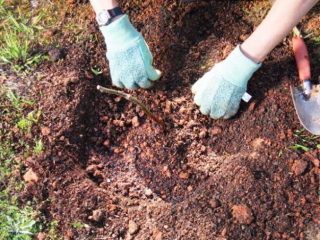Content
Growing grape bushes is not so easy. Especially when it comes to reproduction. You can get new bushes in different ways: by planting seedlings, cuttings and grafting. Today we will talk about how to get a grapevine using one of the vegetative methods - cuttings.
Autumn grape propagation gardeners consider the cutting method of planting in the ground to be the most successful, especially. After all, with the arrival of spring, young plants receive an impetus for development, and the first bunches are removed from them already in the second year. How to plant autumn grapes cuttings or chibouks, what points you should pay attention to - this is the topic of the article.
Important nuances
If you want to get cuttings yourself, you should take care of healthy planting material long before planting. Chubuki are cut from mother bushes that have shown themselves to be excellent during the fruiting period, without the slightest signs of disease.
Cuttings with mechanical damage or elongated internodes should not be used for propagation. Thinned and twisted planting material is also discarded.
Mother bushes are chosen in advance; you can even make marks on them so that in the fall the branches do not get confused due to the rapid growth of the vine. They begin to prepare the cuttings when the leaves fall off the grape bushes. Cuttings or chubuks are prepared from fruited grapes.
How to determine if a vine is ripe:
- branches become light brown;
- a green shoot, if taken in your hand, will be much cooler than a vine ready for cutting;
- mature cuttings placed in a 2% iodine solution will change its color: the solution will turn blue. Fat shoots are not suitable for cutting cuttings, since they are incapable of producing a root system.
- cuttings must be at least 10 cm in diameter, with 3 or 4 live buds;
- The length of the chibouk is approximately half a meter.
Preparation of cuttings
Whether the planted grapes will take root depends on how the vine cuttings are carried out and the preparation of planting material. Therefore, this work must be taken very seriously.
In other cases, the cutting material is wrapped in a wet napkin and placed in a plastic bag.
- To cut cuttings you need to use a sharp knife or pruning shears. The main thing is that when slicing, there are no creases or flattening of the bark. Pay attention to the cut: in a mature cutting it will be white. The eyes on the grapevine should sit firmly and not fall off when lightly pressed.
- During cuttings, the cut is made obliquely, with the lower part of the cut being made next to the eye, and the upper part 2 or 3 cm above the remaining buds.The cuttings are placed in water for 48 hours, then the cut is treated with melted paraffin and again in water for a day, but with a root growth stimulator.
- The cuttings are placed in sawdust or soil to which a root growth stimulator has been added. Subsequently, the seedlings are watered, preventing the top lump of earth from drying out.
If for some reason it is not possible to plant the cuttings in a permanent place in the fall, they can be saved until spring tied in bunches in the basement or buried outside in trenches and covered for the winter.
We invite you to watch a video of how grape cuttings are prepared:
Soil for grapes
Planting grapes from cuttings in the fall can be done in any soil, since grapes are an unpretentious plant in this regard. Although some nuances still exist. Table and dessert grape varieties love different soils and are planted differently.
If you decide to propagate table grape varieties with chibouks, it is best to plant them in humus-rich soil on the slopes of hills. Moreover, the groundwater in this place should be at a depth of three meters.
Vineyards thrive on rocky and dark soil. It warms up better because it attracts the sun's rays more strongly.
Types of soils that grapes love:
- clayey;
- weakly carbonate or carbonate;
- light-colored sandstone;
- black soil;
- red soil;
- sandy loam soil;
- gray soils;
- light and dark chestnut soils.
In a word, the soil should be light, breathable and fertile. During the growing season, after you plant the grape cuttings, the soil must be constantly loosened.
Planting holes or trenches are prepared in advance and fertilizer is added to them. Before planting the cuttings, the soil must settle well.
Choosing a landing site
If we are talking about planting grapes with stems in the ground in the fall, we need to choose the right place:
- You can't plant grapevines there, the old plantation has just been uprooted. Spores of fungal and viral diseases, as well as insects, may remain in the soil. Planting can begin only after 2-3 years.
- Ventilation is important for grapevines, so you should not plant cuttings between trees or in the shade.
- Seedlings obtained from cuttings are planted in the direction from south to north. In this case, the vineyard will be illuminated from morning to evening, the entire plantation will receive enough heat and light.
Preparing the planting hole
Grape stems are planted in holes or trenches. When digging, the soil is thrown on both sides. In one direction the top, with fertile soil from a depth of no more than 30 cm. The rest of the soil is laid on the other parapet. It is then generally removed from the site. The width of the trench should be at least 80-90 centimeters.
If planting grape cuttings in the fall is carried out in holes, then they should be 80x80 cm. The depth of the trench and hole is also at least 80 cm. The place where the cuttings are planted should be spacious, since growing grapes have a powerful root system, it should not feel cramped.
The bottom is covered with drainage (fine crushed stone can be used); at least two buckets of humus and mineral fertilizers must be laid on top.
Humus and fertilizers are mixed, and a layer of fertile soil, previously removed from the pit, is poured on top. The fact is that it is impossible to plant chibuki directly on humus. They will get burns and the development of the root system will not occur.
Planting cuttings
Planting grapevines is not such an easy job; it requires attention and patience. The harvest depends on how correctly the future grapes are planted.
It would be a good idea to watch a detailed video before starting work, because every gardener does things differently:
And now about how to plant cuttings correctly:
- Planting of cuttings begins in the fall in October. Work can be carried out before the first freezing of the soil.
- There should be at least 2.5 meters between planted plants.
- There is a 3 meter indentation between the grape rows.
- The cutting is buried in the soil and buried in soil and the soil around it is trampled. When planting grapes, you need to ensure that at least two buds remain on the surface.
- After this, a plastic bottle is placed on each cutting and soil is spilled.
When the water is absorbed, the soil needs to be loosened to restore the access of oxygen to the depths. Since planting grapes in the fall is done at temperatures close to zero, the cuttings must be immediately covered with pine needles. You can also use sawdust or peat. The height of the mound, which can protect the grape plantings from frost, must be at least 30 cm.
Already in the fall, an excellent root system is formed on the stems, so in the spring the rapid vegetative development of the young seedling begins.
Instead of a conclusion - advice
Everyone knows that grapes are a heat-loving plant. The root system cannot withstand temperatures below – 5 degrees. Therefore, after planting the cuttings, it is mulched, and the seedlings are covered for the winter.
When planting cuttings, point the eyes south or in the direction of the trellis. Then it will be easier to work with grapes.
When the first snow falls, even a small amount, it is advisable to sprinkle it in a mound on the young plantings.















